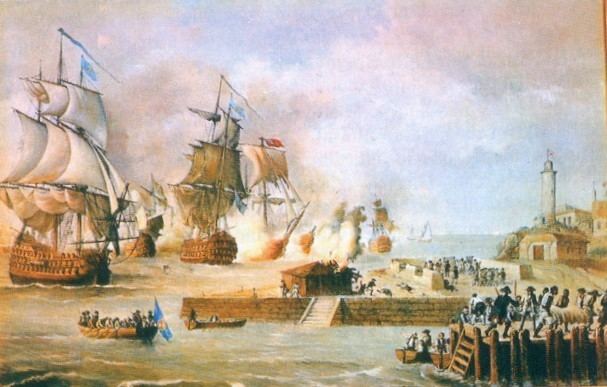Preceded by Pedro Fidalgo Name Melchor Navarrete | Succeeded by Basilio de Gante Preceded by Juan Jose de Clou | |
 | ||
Succeeded by Fulgencio Garcia de Solis Succeeded by Alonso Fernandez de Heredia Died August 28, 1761, Cartagena, Colombia | ||
Melchor de Navarrete y Bujanda (1693–1761) was a Spanish soldier and administrator who served as governor of Cartagena de Indias, Colombia, from 1739 to 1742; of Spanish Florida from 1749 to 1752; and of Yucatan, Mexico, from 1754 to 1758. He was linked to several cases of corruption in Cartagena.
Contents
Early years and government in Cartagena
Melchor de Navarrete was born on January 17, 1693, in the town of Briones, Spain, to Francisco de Navarrete, the governor of Briones, and Josefa Bujanda y Banuelos. His siblings were Javier and Teresa de Navarrete y Bujanda. He joined the Spanish Royal Army in his youth and eventually became a field marshal.
In 1736, he moved to Cartagena to become lieutenant to the king. Three years later, after the death of Governor Pedro Hidalgo, he was appointed acting governor of the city. He was in charge of administration and food supply, while Admiral Blas de Lezo held the military command. In 1740, Navarrete entered the Order of Santiago and gained the title of field marshal of the Spanish Royal Army. In 1741, he participated in the Battle of Cartagena de Indias, fighting against Admiral Edward Vernon of Britain, who tried to conquer the fortress of the city. In that campaign, Navarrete was accompanied by Admiral de Lezo and Viceroy of New Granada Sebastian de Eslava, the lieutenant general of the Spanish Royal Army.
In June, Navarrete wrote a letter to the Marques de la Ensenada asking him to ensure that food was sent to Cartagena. In July, the city received 100,000 pesos from commerce.
In 1742, Navarrete was charged with several crimes by the officers of the Royal Treasury. The officers demonstrated that Navarrete had given shopping guides to a French trader, Jean Lehen Brignon, without paying royalties in exchange for 15,000 pesos, and they suspected that it was Navarrete himself who had cashed the commission. In response to these accusations, Viceroy Eslava replaced Navarrete as acting governor of Cartagena with Brigadier Basilio de Gante, and rejected Navarrete's petition to recover his office. The viceroy also suspended Navarrete as royal lieutenant.
However, Navarrete's wife belonged to one of the most important merchant families in Cartagena, and in 1749, he got enough money to be named governor of Florida. He also regained his position as lieutenant to the king until he traveled to Florida to assume his charge as governor. In spite of this, Colonel Diego de Pino, a smuggler who belonged to Cartagena's elite, accused Navarrete of many crimes: He had married after the king denied his license; when the English invaded Cartagena, he had forced more than 500 residents to leave the city; and he had allowed a frigate carrying 200,000 pesos of contraband into port in exchange for 8,000 pesos. Viceroy Eslava — who feared that his opponents, the sailors of the Marques de la Ensenada's political party, would try to prevent him from holding the office of viceroy of Peru, as later happened — allowed Navarrete and his wife to travel to Florida.
Government of Florida and Yucatan
On August 8, 1749, Navarrete was appointed governor of Spanish Florida. In that role, he defended the region in the War of Jenkins' Ear. He left office on July 3, 1752.
In 1752, he was admitted as a knight of the Order of Santiago. In 1754, he was appointed governor and captain general of the Mexican province of Yucatan and its capital, Merida. During his tenure in Yucatan, complaints were raised about the forced labor of the Mayas, the indigenous people of the peninsula, who were enslaved by encomenderos and forced to produce cotton. Navarrete defended the position of the encomenderos and forced the Mayan chiefs to write a declaration that was forwarded to the Council of the Indies and King Ferdinand VI. They approved the declaration, and the forced work continued.
Navarrete also participated in a military campaign against privateers who had attacked the Yucatan coast in 1754. Ships and fleets came from Mexico City, Campeche, Bacalar, Honduras, and Havana to take part in the campaign. The Spanish troops conquered Valis, captured many ships and soldiers, and burned all privateer settlements they found (although later, Valis was reconquered by the English, and privateer attacks continued).
Also under the Navarrete administration, the Campeche council requested permission to build a powder magazine away from the town plaza, where fires were frequently started by summer lightening storms. The powder magazine was completed in 1758, the same year that Navarrete finished his term in Yucatan. After that, he returned to Cartagena, where he died on the evening of August 28, 1761.
Personal life
On May 28, 1740, Navarrete married Maria Micaela de Sanz y de la Roche. They had three children: Maria Antonia, Maria Josefa, and Maria Francisca de los Dolores.
